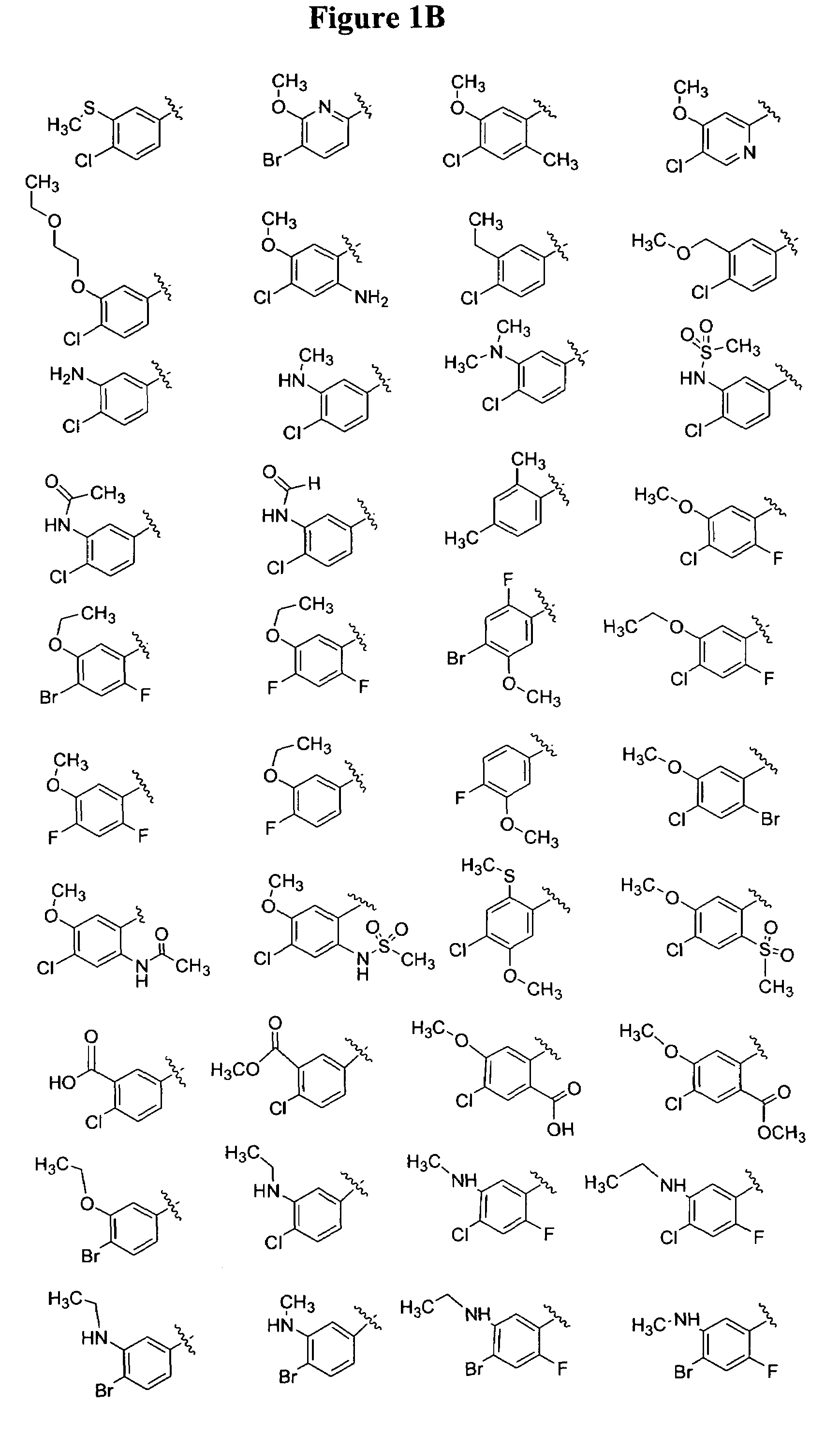Substituted piperazines
a technology of substituted piperazines and substituted piperazines, which is applied in the direction of anti-inflammatory agents, drug compositions, immunological disorders, etc., can solve the problems of inability to fully absorb the drug, short half-lives once administered, and prohibitive development and manufacturing costs, so as to improve the solubility of water and increase the partitioning into selected solvents
- Summary
- Abstract
- Description
- Claims
- Application Information
AI Technical Summary
Benefits of technology
Problems solved by technology
Method used
Image
Examples
example 1
[0158]The piperazine ring can be formally attached to the terminal aryl unit in a number of ways: by aromatic nuclephilic displacement reactions, metal catalyzed coupling reactions (arylation reactions of secondary amines), ring expansion, rearrangement and cyclization reactions and the like. Also, different protection / deprotection strategies can be utilized. Hence, either all or only part of the final molecular architecture can be present during the key aryl coupling step. Examples for a variety of such aryl coupling strategies are listed below.
Protocol A: Metal Catalyzed Arylation Reactions of Secondary Amines
Synthesis of (5-Chloro-2-piperazin-1-yl-phenyl)-phenyl-methanone
[0159]
[0160]Piperazine (3.6 g, 42.5 mmol), Pd(II)acetate (0.007 g, 0.043 mmol), sodium t-butoxide (0.22 g, 2.4 mmol) and BINAP (0.042 g, 0.068 mmol) were stirred at room temperature in 10 mL dry toluene for 15 min. (2-Bromo-5-chloro-phenyl)-phenyl-methanone (0.5 g, 1.7 mmol) in 10 mL dry toluene was then added in...
example 2
[0881]Protocols referred to within the following example are the protocols described within Example 2.
Protocol A: Metal Catalysed Arylation Reactions of Secondary Amines
Synthesis of 1-[4-(4-chloro-3-methoxy-phenyl)-[1,4]diazepane-1-carboxylic acid t-butyl ester
[0882]
[0883]A mixture of 5-bromo-2-chloroanisole (1.10 g, 5 mmol, 1.0 equiv), N-Boc-homopiperazine (1.0 g, 1 equiv), NaOtBu (0.72 g, 1.5 eq), racemic-BINAP (58 m g, 0.015 equiv) and Pd2 Dba3 (28 m g, 0.005 eq) in 3 mL of toluene was heated at 90° C. overnight. After cooling to room temperature, the residue was taken up in EtOAc and washed with water and brine. The organic layer was dried over Na2SO4, filtered, evaporated and subjected to flash column (1:4 EtOAc / hexane) to give 1-[4-(4-chloro-3-methoxy-phenyl)-[1,4]diazepane-1-carboxylic acid t-butyl ester. 1H NMR (400 MHz, CDCl3) δ 7.13 (d, 1H), 6.22 (d, 1H), 6.20 (dd, 1H), 3.86 (s, 3H), 3.45 (m, 6H), 3.32 (m, 2H), 3.20 (m, 2H), 1.95 (m, 2H), 1.20 (s, 9H). LCMS observed for (...
example 3
[1423]Protocols referred to within the following example are the protocols described within Example 3, unless otherwise indicated.
Protocol A: Metal Catalysed Arylation Reactions of Secondary Amines
Synthesis of 1-[4-(4-Chloro-3-methoxy-phenyl)-piperazin-1-yl]-2-(4-chloro-5-methyl-3-piperazin-1-yl-pyrazol-1-yl)-ethanone
[1424]
[1425]Following Protocol A from example 1, A mixture of 2-(3-iodo-4-chloro-5-methyl-pyrazol-1-yl)-1-[4-(4-chloro-3-methoxy-phenyl)-piperazin-1-yl]-ethanone (204 mg, 1 equiv), piperazine (430 mg, 10 equiv), —Xantphos (40 mg, 0.3 equiv), Pd2(dba)3 (72 mg, 0.1 equiv) and Cs2CO3 (200 mg, 1.5 equiv) in 1 mL of THF were heated at 70° C. overnight and then cooled to room temperature, taken up in EtOAc, washed with water. The organic layer was purified by reverse phase HPLC (acetonitrile-H2O with 0.1% TFA as eluent) to yield the title compound: LCMS Retention time: 3.07 minutes (Agilent Zorbax SB-C18, 2.1X50 mm, 511, 35° C.) using a 4.5 minute gradient of 20% to 95% B wit...
PUM
 Login to View More
Login to View More Abstract
Description
Claims
Application Information
 Login to View More
Login to View More - R&D
- Intellectual Property
- Life Sciences
- Materials
- Tech Scout
- Unparalleled Data Quality
- Higher Quality Content
- 60% Fewer Hallucinations
Browse by: Latest US Patents, China's latest patents, Technical Efficacy Thesaurus, Application Domain, Technology Topic, Popular Technical Reports.
© 2025 PatSnap. All rights reserved.Legal|Privacy policy|Modern Slavery Act Transparency Statement|Sitemap|About US| Contact US: help@patsnap.com



